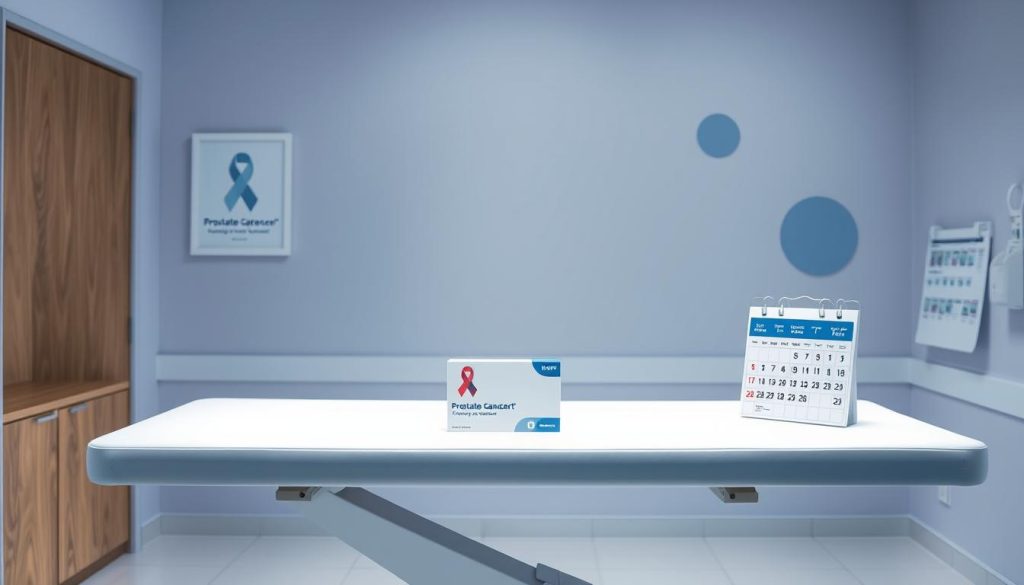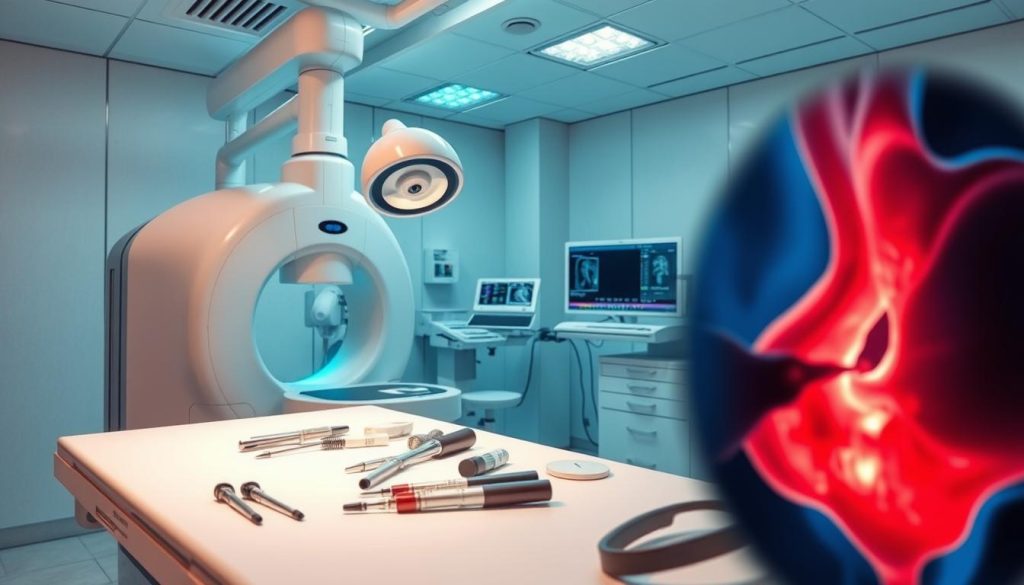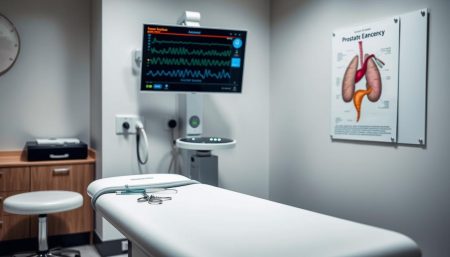Prostate cancer screening is key to catching it early. This guide covers the different ways to test for prostate cancer. It includes everything from first screenings to detailed tests. Knowing about these tests helps men make smart health choices.
Doctors start by using simple tests to check for prostate cancer. These tests can find problems before symptoms show up. Later, more detailed tests might be needed to confirm the cancer and how far it has spread.
It’s important to know the signs of prostate cancer, but many men don’t notice them early on. That’s why regular check-ups are crucial, especially for those at higher risk. This guide aims to educate you on the testing process. It’s all about keeping your prostate health in check.
Understanding Prostate Cancer Screening Basics
Prostate cancer screening is key to finding this common cancer early. It helps lead to better treatment options. Let’s look at the basics of prostate cancer screening and who should get it.
Who Should Get Screened for Prostate Cancer
Screening advice changes based on risk. Generally, men should talk to their doctor about screening at:
- Age 50 for average-risk men
- Age 45 for high-risk men (African Americans or those with a family history)
- Age 40 for men with multiple high-risk factors
The Importance of Early Detection
Prostate cancer screening early on can greatly improve treatment success. Early detection means the cancer is often easier to treat and may need less aggressive treatments.

Risk Factors That Influence Testing Frequency
Several risk factors can change how often a man should be screened:
| Risk Factor | Impact on Screening |
|---|---|
| Age | Risk increases with age; more frequent screening needed |
| Family History | Higher risk; earlier and more frequent screening recommended |
| Race | African American men at higher risk; earlier screening advised |
| Genetic Mutations | BRCA1/2 mutations increase risk; more vigilant screening needed |
Knowing these risk factors helps men decide on their screening schedule. It’s important to talk to a healthcare provider about your risk to find the best screening plan.
How Do They Test For Prostate Cancer
Doctors use many steps to find prostate cancer. They mix screening methods with advanced techniques. This helps find cancer cells in the prostate gland.
Initial Screening Methods
The first steps in testing for prostate cancer include two main tools:
- PSA Blood Test: Checks prostate-specific antigen levels in the blood
- Digital Rectal Exam: A physical check for prostate issues
These tests look for signs of prostate cancer. They decide if more tests are needed.
Advanced Diagnostic Procedures
If early tests show concerns, doctors might suggest more detailed tests:

- MRI Fusion Biopsy: Uses MRI and ultrasound for accurate tissue samples
- PET Scan: Finds cancer spread with radioactive tracers
- Transrectal Ultrasound: Gives detailed prostate images
Testing Timeline and Process
The testing for prostate cancer usually goes like this:
| Stage | Duration | Procedure |
|---|---|---|
| Initial Screening | 1-2 weeks | PSA test and DRE |
| Advanced Imaging | 2-3 weeks | MRI or PET scan |
| Biopsy | 1-2 days | Tissue sample collection |
| Results | 1-2 weeks | Pathology report |
Knowing how prostate cancer is tested can help reduce worry. Regular tests and talking to your doctor are important. They help find cancer early and manage it well.
PSA Blood Test and Digital Rectal Examination
Prostate cancer screening uses two main tests: the PSA test and digital rectal exam. These help find cancer early, which can lead to better treatment.
The PSA test checks for prostate-specific antigen in the blood. High levels might mean cancer, but other things can also raise them. PSA levels can be affected by age, health, medicines, and more.
A digital rectal exam lets a doctor feel the prostate for any unusual areas. It’s a hands-on way to find lumps or hard spots that could be cancer. Though not as accurate as the PSA test, it gives important physical details.
“The combination of PSA testing and digital rectal exams offers a more comprehensive screening approach for prostate cancer.”
But, these tests have their limits. PSA levels can be high even without cancer, causing false alarms. Digital rectal exams might miss small tumors. Still, they are key in finding prostate cancer.
Your doctor might suggest more tests based on the first results. These could include percent-free PSA or complexed PSA tests. They offer more details and help decide if a biopsy is needed.
Advanced Diagnostic Methods and Imaging Tests
Prostate cancer diagnosis has become more advanced with new technologies. These tools give detailed views of cancer’s presence, location, and size. Let’s look at some of these advanced techniques used in finding prostate cancer.
MRI Fusion Biopsy Technology
MRI fusion biopsy uses MRI and ultrasound together for better targeting. This method makes prostate biopsies more accurate, helping find cancer better. It lets doctors focus on specific areas of concern.
PET Scan for Prostate Cancer
PET scans use radioactive tracers to spot cancer cells. For prostate cancer, PSMA PET scans are especially good. They can find small cancer spots that other tests might miss.
Bone Scans and CT Imaging
Bone scans check if cancer has spread to bones. CT scans show detailed body images. These tests are key for understanding cancer’s stage and planning treatment.
| Diagnostic Method | Purpose | Advantages |
|---|---|---|
| MRI Fusion Biopsy | Targeted prostate biopsy | Higher accuracy, fewer samples needed |
| PET Scan | Detect cancer spread | Can find small metastases |
| Bone Scan | Check for bone metastases | Whole-body assessment |
| CT Imaging | Staging and treatment planning | Detailed anatomical information |
These advanced tests greatly improve prostate cancer diagnosis. They help doctors choose the best treatments, leading to better results for patients.
Prostate Biopsy Procedures and What to Expect
A prostate biopsy is key in finding prostate cancer. It helps doctors see if cancer cells are there and what stage it’s at. We’ll look at the types of biopsies, how to get ready, and what happens next.
Types of Prostate Biopsies
There are two main types of prostate biopsies: transrectal and transperineal. In a transrectal biopsy, a needle goes through the rectum to get tissue samples. A transperineal biopsy takes samples through the area between the scrotum and rectum. Both methods help doctors check prostate cells for cancer.
Preparation Guidelines
Before your biopsy, your doctor will give you specific instructions. You might need to stop taking certain medications, like blood thinners. Tell your doctor about all the medications you’re taking. You could also get antibiotics to prevent infection. Some doctors suggest using an enema before to clean the bowels.
Recovery and Results Timeline
After the biopsy, you might feel a bit uncomfortable and see blood in your urine or semen for a few days. These symptoms usually go away by themselves. Results usually take about a week to come back. Your doctor will talk to you about the findings, including if cancer cells were found and the stage of the cancer. This info helps decide on treatment and what to do next.
FAQ
Q: What are the main methods used to test for prostate cancer?
A: To test for prostate cancer, doctors use several methods. These include the PSA blood test, digital rectal examination (DRE), and prostate biopsy. They also use MRI, PET scans, and CT scans for detailed diagnosis and staging.
Q: At what age should men start getting screened for prostate cancer?
A: Men should talk to their doctor about prostate cancer screening at 50. But, African American men or those with a family history of prostate cancer might start earlier, around 40-45.
Q: How often should prostate cancer screening be done?
A: How often you need a prostate cancer screening depends on your risk factors and PSA test results. If your PSA levels are normal, you might need a screening every 1-2 years. Your doctor will tell you if you need more frequent tests.
Q: What is a PSA test and how is it performed?
A: A PSA test checks the prostate-specific antigen in your blood. It involves drawing a small blood sample from your arm. High PSA levels might mean prostate cancer, but other issues can also raise them.
Q: What happens during a digital rectal exam (DRE)?
A: During a DRE, a doctor feels your prostate gland through your rectum. They look for any unusual sizes, shapes, or textures that could suggest cancer. The exam is quick and might feel a bit uncomfortable but is not usually painful.
Q: What is an MRI fusion biopsy?
A: An MRI fusion biopsy uses MRI and ultrasound to guide a biopsy needle. It targets specific areas in the prostate for more accurate cancer diagnosis.
Q: How is a prostate biopsy performed?
A: A prostate biopsy uses a thin needle to take tissue samples. It’s usually done through the rectum wall with ultrasound guidance. Local anesthesia is used to make it less uncomfortable.
Q: How long does it take to get results from a prostate biopsy?
A: Getting biopsy results usually takes 1-2 weeks. A pathologist examines the tissue to see if cancer is present and its type and stage.
Q: Are there any risks associated with prostate cancer testing?
A: Prostate cancer testing is mostly safe, but there are some risks. PSA tests and DREs are low-risk. Biopsies might cause infection, bleeding, or urinary problems. Always talk about the risks and benefits with your doctor.
Q: Can prostate cancer be diagnosed without a biopsy?
A: While PSA tests and DREs suggest prostate cancer, a biopsy is needed for a sure diagnosis. Advanced imaging like MRI is used to decide if a biopsy is needed and to guide it.


















